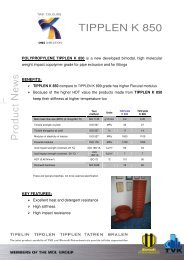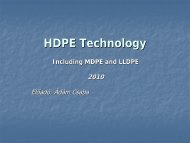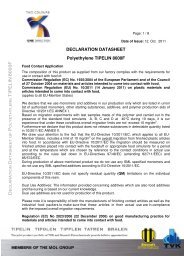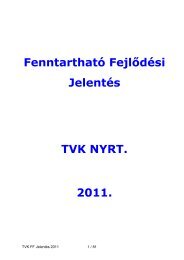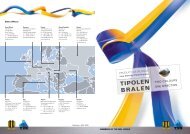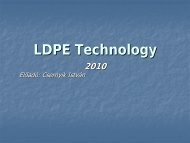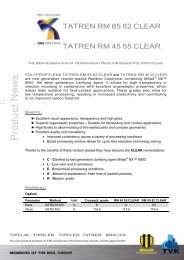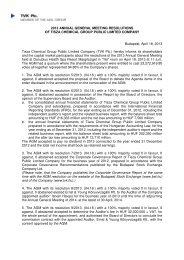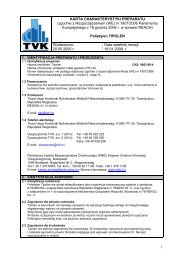OLEFINS PRODUCTION - TVK
OLEFINS PRODUCTION - TVK
OLEFINS PRODUCTION - TVK
- No tags were found...
Create successful ePaper yourself
Turn your PDF publications into a flip-book with our unique Google optimized e-Paper software.
<strong>OLEFINS</strong> <strong>PRODUCTION</strong>Olefins by steam crackingContentImportance of ethylene and propylene in the chemicalindustryHistoryCharacteristics of steam crackingRaw materials and productsSteam cracking processes, steam cracking at <strong>TVK</strong>Safety aspectsControl systemsKey equipmentOverview of investment and operating costs2
Importance of ethylene andpropylene in the chemical industry3Lower olefins: ethylene and propyleneThe largest volume petrochemicals producedThe largest volume petrochemicals producedAnnual global production of ethylene is about120 million tons with a continuous annualincrease of some 4 - 5 %Ethylene and propylene have no end use, theyare building blocks for a large variety ofchemicals and petrochemical productsPolymers are the dominating end-users4
Building block for petrochemicals – ethyleneconsumption 2009Styrene6%VAM1%Others6%EDC (PVC)12%Ethylene oxide14%PE61%5Building block for petrochemicals –propylene consumption 2009Isopropanol2%Acrilic acid4%Cumene5%Others11%Propylene oxide7%Acrylonitrile7%PP64%6
Main drivers for ethylene and propylenedemand: : PE and PP7Global consumption of ethylene andpropylene120100EthylenePropylene80million t/yr60402001990 1992 1994 1996 1998 2000 2002 2004 2006 2008 20108
Hungary: ethylene produced by <strong>TVK</strong> onlyRAW MATERIALS FROM MOL(NAPHTHA AND GAS OIL)ETHYLENE TO BORSODCHEMLDPE-265 kt/yrCUSTOMERSOLEFIN-1370 kt/yrPP-3100 kt/yrHDPE-1200 kt/yrCUSTOMERSOLEFIN-2290 kt/yrHDPE-2220 kt/yrPP-4180 kt/yrCUSTOMERSPROPYLENE TO SPCBY-PRODUCTS TO MOL(ISOBUTILENE, BT CUT, C8 AND C9 CUT)FUEL OIL TO CARBON BLACK PRODUCER9History10
Ethylene milestones1913: Standard Oil’s scientist patented thermal crackingprocess1930ties: Ethylene was first separated from coke ovengas and the first commercial plant for the production ofethylene was built by Linde at that time1941: Standard Jersey (ExxonMobil’s predecessor)developed the world’s first steam cracker at Baton Rouge1950ties: Ethylene emerged as a large-volumeintermediate, replacing acetylene as prime material forsynthesisToday ethylene is primarily produced by thermal crackingof hydrocarbons in the presence of steam. Plantcapacities are up to 1-1,5 million t/yr ethylene.Other processes are also available or under development11Olefin production by processes, 200812010080million t6040200ethylenepropylenesteam cracking refinery operation others12
Ethylene at <strong>TVK</strong>1975: First steam cracker with Linde processstarted operation– Original nameplate capacity: 250 kt/yr ethylene– After several debottlenecking nowadays the actualcapacity is 370 kt/yr2004: Second cracker (also Linde process)with 250 kt/yr capacity was commissioned– Today the capacity is 290 kt/yr13Present and future processes to ethyleneand propylene productionSteam crackingdominating technologyRefinery processesMTO Methanol to Ethylene andPropyleneMTP Methanol selectively to PropyleneSyngas via Fisher TropschGreen Ethylene- Biomass via Fermentation to Ethanoland Dehydration of Ethanol- Biomass > Syngas > Fischer Tropschminor importance for ethyleneimportant for propylene onlytechnology is ready butnot yet commercializedcommercialisation phaseminor importancecommercialisation phasestudy phase14
Characteristics of steam cracking15What is steam cracking?Steam cracking is a pyrolysis processA hydrocarbon mixture is heated in metal tubes inside afurnace in the presence of steam to a temperature atwhich the hydrocarbon molecules thermally decomposesFor ethane the primary reaction is dehydrogenationC2H6 → H2C=CH2 + H2Other free radical reactions also occur– Cracking and dehydrogenation of longer molecules resulting inhydrogen, methane, ethylene, propylene, butadiene and heavier– Continued dehydrogenation to form acetylene, aromatics andcokeThese reactions require a residence time of less thanone second and are endothermic16
Principle of the cracking process17Tasks of a cracking furnaceProduction of ethylene and propylene byendothermic cracking reactionPreheating of feed and dilution steam byutilization of waste heatCooling of the cracked gas to freeze chemicalreactionsProduction of superheated HP steam byutilization of waste heat18
Raw materials and products21From raw materials to productsCracking is only part of the story: crack gashas to be separatedHydrogenFuel gasFeedstockSteamPyrolysissectionCrack gasRecoverysectionEthylenePropyleneC4GasolineOil22
Wide range of feedstocksGaseous feeds– Ethane– Propane– N-butane/i-butaneLiquid feeds– Condensates from natural gas– Naphtha– Atmospheric gas oil (AGO)– Hydrocracker residue (HCR), hydrogenated vacuumgas oil (HVGO)23Liquid feedsMain components– Paraffins– Naphthenes– Olefins and aromatics (associated components in heavy feedstocks)3,503,00H/C mole ratio2,502,001,501,00Ethylene&NaphthaPropyleneAGOParaffinsHVGOVGOAromaticsHCRResidue0,500,000 5 10 15 20 25 30 35 40Carbon number24
Cracked gas composition vs. feedstockwt %EthanePropanen-c4/i-c4NaphthaAGOH2 + CO4.061.701.231.030.71CH43.6723.3721.7515.3510.69C2H20.500.670.500.690.34C2H452,4539.6531.7431.0224.85C2H634.764.573.673.422.75C3H6 + C3H41.1513.2819.8516.2114.28C3H80.127.420.690.380.31C42.244.0312.909.549.61Pyrolysis Gasoline0.874.276.4119.3320.6Pyrolysis Fuel Oil0.161.111.263.0115.7825Severity vs. product yieldYields for naphtha feed%403530252015105P/E0,40,50,60Ethylene Propylene Hydrogen Fuel gas C4 Gasoline Oil26
Considerations for feedstocksParaffins are the best raw materialsLower carbon number gives higher ethyleneyieldCracking severity influences product yieldSteam crackers are mostly integrated intorefineries therefore– both gaseous and liquid feeds are used,– profitability is very complex issue and evaluatedtogether with refinery operation27Steam cracking processesSteam cracking at <strong>TVK</strong>28
Process design considerationsEthylene process is one of most complex systems inpetrochemical industry. The following challenges haveto be faced:– Safety first– High energy efficiency and minimum environmentalemissions– Low production costs and low investment costs– High plant reliability– Simple operation– Good maintainability– Minimum losses29Material and energy streams at <strong>TVK</strong>Olefin-2Natural gasSteamElectric powerNaphthaGasoilLPG (propane, butane)Olefin-2Methane (to fuel gas)Hydrogen TIFOEthylene PE productionPropylene PP productionBT fraction MOLC8 fraction MOLC9+fraction MOLQuench oil CTKEthane (repyrolysis)Propane (repyrolysis)C4/C5 (repyrolysis)30
Olefin process overview31Cracking furnacesRadiant section: thermal cracking reactions (800 – 850 °C)Convection section: heat recovery from hot flue gas– Feed preheating– Boiler feed water preheating– Process steam superheating– HHP steam superheatingLinear quench exchanger– Freezing cracking reactions in order to avoid productlosses by secondary reactions (400 - 600 °C)– Heat recovery -> > HHP steam productionOlefin-1 1 and Olefin-2 2 represent two generations– O-1: 11 furnaces– O-2: 4 furnaces32
Cracking furnace in Olefin-2Quench exchangersConvection sectionRadiant coilsSide-wall burnersFloor burners33Tube arrangement in the radiant zone(Olefin-2)34
Hot section in O-2OFurther cracked gas cooling by direct oil injectiondownstream the quench coolers (220 - 250 °C)Oil Fractionation (primary(fractionation) ) and QuenchOil Cycles• Two quench oil cycles (Pyrolysis(Fuel Oil and Pyrolysis Gas Oil)are used as heat carrier to cool the cracked gas (~100 °C) andto shift the recovered heat to consumers• Both quench oil cycles are formed by condensing the heavyends of the cracked gas• Process steam generation by hot quench oilWater Scrubbing (Water quench column)• Cracked gas is cooled by water circulation to ambient (~30 °C)temperature to condense heavy gasoline and process (dilution)steam• Circulating water is withdrawn from the bottom of the columnand pumped to several consumers for low temperature heatrecovery35Hot section: Oil fractionating and waterquench column in O-2O36
Cracked gas compressionCracked gas is compressed with a 5-stage 5centrifugal compressor–Suction pressure: 0,5 bar (g)–Discharge pressure: 32-36 36 bar (g)The compressor is driven by anextraction/condensation steam turbine.Process water and gasoline are condensed in theinterstage coolers and knocked out in the interstageseparators. Gasoline is directed to hydrogenationand separation.Caustic Scrubbing: removal of the acid componentsCO2 and H2S in a 3-stage 3caustic scrubber37Cracked gas compressor in Olefin-238
Cold section block diagram39Cold section 1Precooling, , drying, deethanizer– Cracked gas cooling to drying temperature– Cracked gas drying to eliminate water content– Cooling to -40°C C (cooling with propylene refrigerantand cold streams from the low temperature section)– Separation of C2- and C3+ fraction (deethanizer(deethanizer)C3+ processing– C3/C4+ separation– C3 hydrogenation: conversion of methyl-acetylene andpropadiene to propylene and propane– C3H6/C3H8 separation: propylene product, propanerecycle– C4/C5 separation40
Cold section 2C2 hydrogenation– Acetylene is selectively hydrogenated to ethylene– Max. 1 ppm acetylene downstream the catalytic reactorLow temperature section (cold train)– C2 minus fraction is cooled with ethylene refrigerant andexpanded cold streams (-145 C)– Separation of C2 from C1 and hydrogen from methane: ethylene,ethane, and almost all methane is condensed, the remaining gasconsists of a hydrogen-rich rich fractionC2 splitter– To separate ethylene (top product) and ethane (recycled tofeed)41Safety aspects42
About safetySafety first concept has to be applied for a plantduring– design,– construction and– operationin line with the industrial standards and normsSafety is expensive – there is nothing for free43Major risk factors in olefin plantsHigh volume of highly flammablehydrocarbon gases and liquidsExtremely high and low temperaturesHigh pressureCorrosionComplexity of operation44
Plant safety: based on risk evaluationRisk considerationRisk matrixFrequency ofhazardous eventshighProcess riskFrequencymediumConsequence ofhazardous eventslowConsequence45Risk reductionLevels of risk reduction measuresIncidentremote with very serious consequencesfailure of safety systemFailureseldom with serious consequencesfailure of control system, failure of plantcomponents, severe operating failuresProcess upsetfrequent with minor consequencesfailure of control system, utility system, simpleoperating failureProcess variationEmergency ResponseEmergency Response PlanFire Brigade/First AidMitigationMechanical System(e.g. safety valves, blow-down system)Safety Instrumented SystemPreventionInherent DesignMechanical SystemSafety Instrumented SystemOperating InstructionControl and MonitoringBasic Process Control SystemMonitoring System (process alarms)ProcessOperating conditionNormal OperationStart-up/Shut-down46
Example for risk reduction: selection ofconstruction materialsSuitable material is not subject to unexpectedmaterial related failures during the calculated plantlifetime under nominal operation conditionsCalculated plant lifetime: ~15-20 YearsNominal operation conditions:– Specified cases of operation– Design pressure and temperatures, fluidcomposition, flow velocity as specified– Start up– Shut down– Site condition47Example for risk reduction: fire andexplosion protectionProper selection of mechanical equipment to avoidleakagesExplosion proof electric equipment and instrumentationGas detection systemsSteam curtains (e.g. for the furnaces)Closed blow-down systemSafety distances between plant sectionFire proofing insulationFire water systems including hydrants and monitorsWater spray systems48
Control systems49The automation pyramid of a companyManagement levelERP,Planning andScheduling, etc.Operator levelSupervision, Control,Data Acquisition,Advance Control, etc.Controller levelProcess control, PLC, PID, APC,Safety instrumentation, etc.Field levelSensors, Actuators, Switchgears, etc.50
Control systems in O-2O51Key equipment52
Main groups of equipmentFurnacesStatic equipment– Columns, reactors and other pressure vessels– Heat exchangers– Storage tanksRotating equipment– Turbo machineriesTurbo compressorsSteam turbines– Reciprocating compressors– Pumps53Turbo compressors in O-2 O 2 plantCrack gas compressor– Duty: 13,5 MW– Drive: steam turbineEthylene compressor– Duty: 6,5 MW– Drive: steam turbinePropylene compressor– Duty: 4,5 MW– Drive: steam turbine54
Crack gas compressor O-2 O 2 plant2nd and 3rd stage1,35→9,3 bar4th and 5th stage9,0→36 bar1st stage0,3→1,5 bar55Crack gas compressor O-2 O 2 plant56
Crack gas compressor LP section57Steam turbine58
Turbine driven BFW pump59Multistage BFW pump60
Overview ofoinvestment andoperating costs61Investment costsBasis: WE 2010 Q1 Capacity: 800 ktmillion EURISBL 704OSBL 352Other project cost 400Total investment 1 456EUR/t EthyleneSpecific cost 182062
Ethylene production costBasis: WE 2010 Q1/Q2 Capacity: 800 kt<strong>PRODUCTION</strong> COST SUMMARY Quantity Units 2010 Q1 2010 Q2(per ton)(€/ton)Naphtha 3,230 ton 1 651,1 1 755,0Catalyst & Chemicals 3,6 4,0Total Raw Materials Costs 1 655 1 759,0Fuel 0,587 ton 195,1High Pressure Steam (40 bar) 0,750 ton 24,1Cooling Water 0,454 kton 14,0Electricity 0,084 MWh 5,9Other (Utility) 0,145 - 0,3Total Utility Costs 239 259,0Raw material less coproductTotal direct fix costs100%80%Total utility costsTotal allocated fix costsPropylene (0,516) ton ( 427,5) (496,0)Fuel (FOE) (0,813) ton ( 270,2) (293,0)Benzene (0,239) ton ( 172,9) (201,0)C7 - C9 cut (0,267) ton ( 139,6) (154,0)Butadiene (0,148) ton ( 137,4) (186,0)Other (0,391) ton ( 214,9) (227,0)Total Co-Products ( 1 363) (1 557,0)60%40%Total Variable Costs 531 461,020%Total Direct Fixed Costs 38,8 38,0Total Allocated Fixed Costs 31,8 31,0Total Cash Cost 602 530,00%2010 Q12010 Q263



